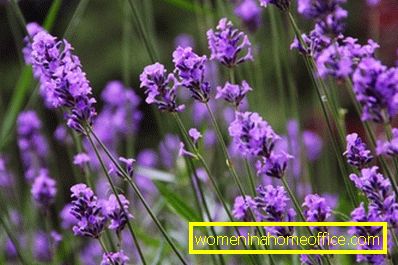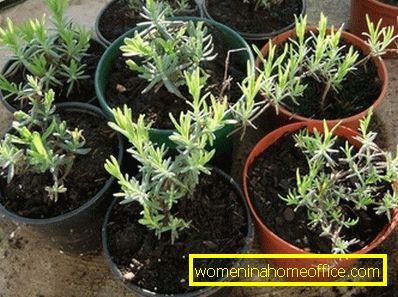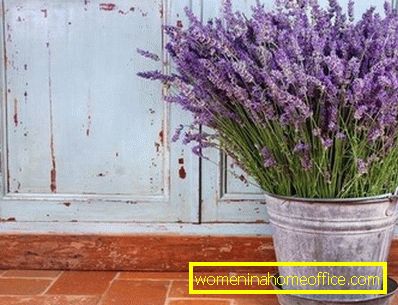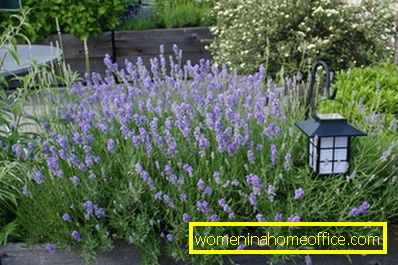Lavender at home
Lavender grown at home is a small piece of France on the windowsill. Those flower growers who have this wonderful plant, know what a wonderful aroma it exudes from a light touch to the inflorescences. And although lavender is considered to be a garden crop, growing it on your balcony in a pot does not amount to any particular problems. How to do it correctly, we will tell you in our article.
Types of lavender for growing at home

Commercially, there are more than 30 species of lavender plants. But the most popular are only 3 of them:
- Spanish lavender or as it is called in the people - spikelet. This species received this name due to the conical shape of its inflorescences. It is often used to produce essential oils and is valued for its unsurpassed fragrance.
- English lavender is a perennial small shrub that is most popular with gardeners. This type of lavender is also often used in cooking and even in production.
- French lavender has a less intense odor and small purple inflorescences. This species does not exceed the size of 50-60 cm in length and width.
For growing in pots, only French lavender seeds are used due to the decorative size of the shrub and not so rich aroma. However, this type of plant is not inferior to its kindred beauty.
Lavender: landing and care

Many growers believe that growing houses lavender is a very difficult thing. Those who have tried to plant this flower in a pot will agree with them. How to grow lavender at home? To avoid the death of a plant, it is enough to follow the basic rules of planting and caring for it:
- choose the right pot and soil;
- closely monitor the temperature;
- water and fertilize the plant on time;
- repot the flower correctly;
- observe wintering regime.
How to choose the soil and pot for lavender?
To get a beautiful and healthy flower in the future, you need to start taking care of the plant before it is planted. Lavender has a very developed root system, so you need a fairly wide pot. It is better to give your preference to containers with a volume of from one and a half to two liters and a diameter of 30-40 cm.
You will also need to provide good drainage for the pot. To do this, you can use the following components:
- small pebbles;
- walnut shells;
- gravel.
Please note that the drain holes in the pot are not clogged with earth.
Lavender loves the soil on an alkaline basis. In order to provide a suitable habitat for this plant, select a mixture of peat with sand and additives from small eggshell.
Temperature and watering

Failure to comply with the temperature and watering rules will certainly lead to the death of the flower. Lavender loves light very much, so the pots of flowers are placed on the southern window-sill, and in the summer they are brought to the open air. But if in the warm season lavender moved to the balcony, it is necessary to protect the plant from the draft. To do this, gradually accustom the flower to cool. On the first day, leave it in the open air for 2 hours; on the second day, increase the time by another hour.
It is recommended to water a lavender only with separated water at room temperature. Ensure that the soil is always slightly wet. If the apartment is too dry and stale air, then you will have to sprinkle and green shoots.
In winter, the pot of lavender is moved to a cool place and limit watering.
Do I need to fertilize lavender?
Not only garden lavender, but also a home decorative flower does not tolerate nitrogenous and organic fertilizers. During the flowering period, a mineral-based top dressing is suitable, and in the usual season it is recommended to fertilize the plant with potassium preparations.
Young flowers of lavender fertilize constantly the first 8-10 weeks. Older plants do not like food, therefore experienced growers recommend doing this procedure 2-3 times a year.
Grow Lavender Seed
niya
After you have bought the necessary container, soil and prepared drainage, you can start planting the plant. Lavender is grown at home on a seed basis, and only an adult plant propagates by cuttings.
Before planting, make sure that the seeds that you use are stratified, otherwise the plant may simply rot in the soil, and you will not wait for the shoots. Stratification - plant seed aging in a wet environment for better growth. This can be done at home:
- For the stratification of lavender, we need 2 cotton pads, a plastic bag and some water.
- We moisten cotton pads with water, pour out on the first 15-20 seeds and close on top with the second copy.
- Wrap the prepared seeds in a plastic bag and put it in the fridge for a month.
- In this case, the bag must be ventilated once a day for a couple of minutes.
After this simple procedure, the seeds are planted in the prepared soil 3 mm deep and removed in a bright, cool place. When the lavender grows to 6 leaves, and it will take about a month, the top must be cut off.
A year later, in order for lavender to grow in a bushy bush, the plant stems are cut to a distance of 15 cm from the soil. The first inflorescences can be observed only two years after planting lavender.
An adult lavender is transplanted by the cutting method, which is usual for all plants. It is best to do this before the flowering period: in early spring or autumn.
What is sick lavender?

Decorative home lavender rarely gives in to any diseases. The worst enemy of the flower in the pot - improper care and watering. Experienced growers recommend that it is better not to finish lavender than to provide it with too wet soil, because in such an environment the rhizomes of the plant simply rot, and the flower will quickly wither.
Pests homemade lavender are not terrible. Very rarely septoria can occur. If this happens, the stems and leaves of the plant are treated with a fungicide.
Useful properties of the plant
Every housewife knows that lavender scares the mole, but this does not end the useful properties of a wonderful plant. Decorative and ordinary at first glance, the flower can bring a lot of benefit to the house. We suggest you to get acquainted with several useful ways to use home lavender:
- Lavender calms nerves and relieves stress. To get rid of anxiety and bad mood, just rub your fingers a few dried lavender flowers.
- After a hard day’s work, lavender tea will help you relax. To do this, just pour a teaspoon of inflorescences with boiling water and infuse for a few minutes.
- You can save money on a fabric softener by sewing a sachet with lavender.
- Dried blossoms will be your highlight when baking pies, muffins and cookies.
A small, modest lavender shrub grown at home is an amazing decorative flower. Of course, you will have to take care of him with particular diligence, but for your work you will be rewarded with a large set of useful properties of the plant, which will be useful both in everyday life and for raising your mood, as well as in cooking.